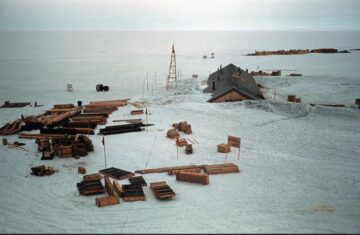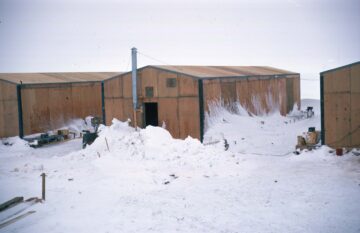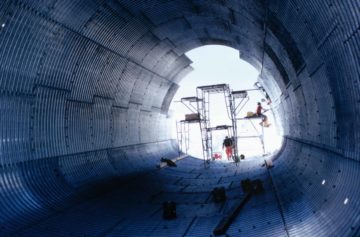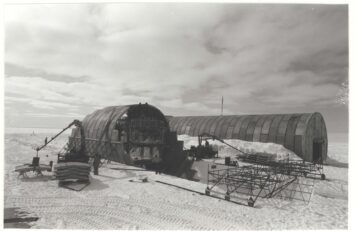Introduction
The original base at Halley was founded on 6 January 1956 by an expedition of the Royal Society as part of International Geophysical Year 1957–58. The bay where the expedition decided to set up their base was named Halley after the astronomer and Fellow of the Royal Society, Edmond Halley. The year 1956 also marked the tercentenary of Halley’s birth. In 1977, the name of the base was amended from Halley Bay to Halley as the original bay had disappeared due to changes in the ice shelf.
Halley is sited on the Brunt Ice Shelf where approximately 1.2 metres of snow accumulate each year. Buildings on the surface become covered and eventually crushed by snow, necessitating periodic rebuilding of the station. This part of the ice shelf is also moving westward by approx. 1km per year. There have been six Halley stations built so far. The first four were all buried by snow accumulation and crushed until they were uninhabitable. Various construction methods have been tried over the years, from unprotected wooden huts to steel tunnels to the present-day distinctive modular design on hydraulic skis.
Location
Position: Lat. 75° 35′ S, Long. 26° 39′ W (2012 Halley VI)
General location: Brunt Ice Shelf, Caird Coast
Previous locations
- 1956 (IGY) Lat. 75° 31′ S, Long. 26° 36′ W
- 1957 (IGY) Lat. 75° 30′ S, Long. 26° 36′ W
- 1967 (Z II) Lat. 75° 31′ S, Long. 26° 39′ W
- 1973 (Z III) Lat. 75° 31′ S, Long. 26° 43′ W
- 1983 (Z IV) Lat. 75° 36′ S, Long. 26° 40′ W
- 1989 (Z IV) Lat. 75° 36′ S, Long. 26° 46′ W
- 1988 (Z V) Lat. 75° 35′ S, Long. 26° 14′ W
- 1992 (Z V) Lat. 75° 35′ S, Long. 26° 19′ W
- 1998 (Z V) Lat. 75° 35′S, Long. 26° 30′ W
- 2001 (Z V) Lat. 75° 35′ S, Long. 26° 34′ W
Purpose
Primarily atmospheric sciences, but also survey, geology and glaciology.
Occupied
6 Jan 1956 to the present.
The 2001/02 season was the only time in the station’s history when sea ice conditions made it impossible to relieve the station by sea.
Buildings
Halley I
The original station, Halley I, or Halley Bay, was established by the Royal Society on 6 Jan 1956 for the International Geophysical Year (IGY) 1957/58. It was a traditional hut with a pitched roof. FIDS took over the operation of the station on 14 January 1959. A new main hut and dog kennels were built close to the original IGY buildings in February 1961, by which time the latter were completely covered by snow. It was closed early 1968.

Halley II
Halley II was built January–March 1967. It was designed with a pitched roof reinforced with steel supports. Halley I and Halley II were both occupied during the 1967 winter, Halley II being known as The Village and Grillage Village. It closed in 1973.

Halley III
Halley III was begun in early 1973. It was built of prefabricated huts housed inside corrugated steel conduits. Halley II and Halley III were both occupied in the 1973 winter. It was closed in February 1984 and the site was cleaned up in 1991.

Halley IV
Halley IV was established 2 January 1983. It was composed of two-storey huts housed inside conduits made from interlocking plywood-faced panels. Both Halley III and Halley IV were occupied in the winter of 1983. It was closed on 19 February 1992 and the site was cleaned up during the 1992/93 season.

Halley V
Halley V was begun in Jan 1989 and was fully operational from 19 Feb 1992. To avoid destruction by accumulating snow the main buildings were positioned on steel platforms that were raised annually so that they remained above the surface. The Laws building, named after Dr R M Laws, Director of BAS 1973-87, was the main accommodation building. The Piggott building, named after Dr W R Piggott, Head of Atmospheric Sciences Division of BAS 1973-79, contained the space sciences laboratories. The Simpson building, named after Sir George Clarke Simpson, meteorologist on Scott’s expedition 1910-13 and Director of the Meteorological Office 1920-38, contained the meteorological laboratories. The Drewry building, named after Dr D J Drewry, Director of BAS 1987-94, provided summer accommodation. Following the example of a new garage installed the year before, the Drewry building was mounted on skis enabling it to be repositioned every year. A Clean Air Sector Laboratory was erected 1km from the main complex in 2002/03.
Continued occupation of the station became precarious as it had flowed too far from the mainland to a position at risk of calving as an iceberg – the legs of the platform on which it was based, were fixed in the ice and could not be moved. Scientific activities at Halley V had to be reduced from the 2007/08 season to aid the construction of Halley VI.
Halley VI
Halley VI Research Station was commissioned in 2006 and its unique and innovative structure was the result of an international design competition launched by the Royal Institute of British Architects (RIBA) and BAS in June 2004. Construction work began in December 2007 and the station took four years to build, delivering its first scientific data in 2012. The completed station consists of five linked modules on hydraulic legs fitted with skis, enabling the units to be towed into new positions.
Halley VI was occupied during the winter 2012 with the official opening on 5 February 2013. The ceremony at the station was attended by Mike Pinnock from BAS, Ed Wallis, NERC Council chairman, and Jeremy Clayton, Department of Business Innovation & Skills. Simultaneously there was an event held at the Royal Society in London, attended by David Willetts, the Minister for Universities and Science, and many others who had made contributions to or had an interest in Halley VI.
Field huts
The Bob-Pi hut was erected in the hinge zone on 6 November 1962. It was used as a depot and staging post for journeys into Coats Land as well as for recreational purposes.
Coats Station was established in Coats Land, at Lat. 77° 54′ S, Long. 24° 08′ W, 200 miles south of Halley Station on 30 November 1964. It was positioned to allow the triangulation of ionospheric measurements to be taken in conjunction with Halley Station and the Argentine General Belgrano Station. It was manned until 18 March 1965 when it was removed.
Memorials
- N S Mann, 15 Aug 1963: plaque at Halley Station.
- J T Bailey, D P Wild and J K Wilson, 12 Oct 1965: plaques erected on Survey Point, Vardeklettane, Heimfrontfjella and at Halley Station.
- M V Mosley, 2 Feb 1980: memorial at Halley Station.
Current status
Operational throughout the year.
For full listing of all station histories, see History of British stations and refuges.
